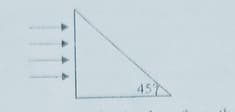Refraction, Deviation and Dispersion of Light through a Prism
Refraction, Deviation and Dispersion of Light through a Prism: Overview
In this topic, we will study the refraction of light through prism, angle of deviation and its dependence, and deviation produced by a thin prism. It also explains the angular dispersion by a prism and its dependence with the help of a figure.
Important Questions on Refraction, Deviation and Dispersion of Light through a Prism
It is desired to make an achromatic combination of two lenses and . If the combination of lenses is converging then
Which one of the following spherical lenses does not exhibit dispersion? The radii of curvature of the surfaces of the lenses are as given in the diagrams.
Which one of the following spherical lenses does not exhibit dispersion? The radii of curvature of the surfaces of the lenses are as given in the diagrams.
In the dispersion of white light by a common glass prism, which one among the following is correct?
The refracting angle of a prism is . What should be the minimum value of the refractive index of the material from which the prism is to be made so that light cannot emerge from the second refracting surface?
I) The speed of light does not depend upon the nature of medium through which it passes.
II) The beam of light is deviated or refrected from its original path as it passes from one medium to another.
III) When a ray of light is passed through a prism, the wave with shorter wavelength bends more than one with longer wavelength.
Which of the following statements is true?
A parallel beam is incident on to a lens of focal length (positive), parallel to its principal axis. A thin prism of vertex angle and refractive index is inserted in the path of the parallel beam before it falls on the lens. The focal point of the image

Glass prism having a refractive index , placed in a air, for that angle of minimum deviation of prism is same as angle of prism. Then what is value of angle of prism?
A mixture of red, yellow and violet light is incident on one face of a prism, at an angle of incidence of . The angle of emergence of the red beam from the other face is . If the angular dispersion of the emerging beam is , then
rays sent to X,Y and Z prisms in the air medium follow the paths in the figures.
What is the relationship between the refractive indices of the X,Y and Z prisms?

A beam of light consisting of red, green and blue colours is incident on a right angled prism. The refractive indices of the material of the prism for the above red, green and blue wavelength are 1.39, 1.44, and 1.47 respectively. The prism will

Refractive index of a transparent material is
Formation of rainbow involves
In which of the following pairs the angle of dispersion will be maximum.
If the refractive indices of flint glass for red, yellow and violet light are and respectively, then find the dispersive power of flint glass.
Dispersive power is dependent on
During dispersion of white light by the glass prism, which of the following light of the spectrum bends the most
Focal lengths of two lens are and and dispersive powers are and respectively. To form achromatic combination from these
The refractive indices of flint glass prism for violet, yellow and Red colours are , and respectively, find dispersive power of the flint glass. (upto five decimal places)
A parallel beam of white light falls on a convex lens. Images of violet, yellow and orange light are formed on the other side of the lens at distances and respectively. What is the dispersive power of the material of the lens ? (Round off your answer upto two decimal places)
